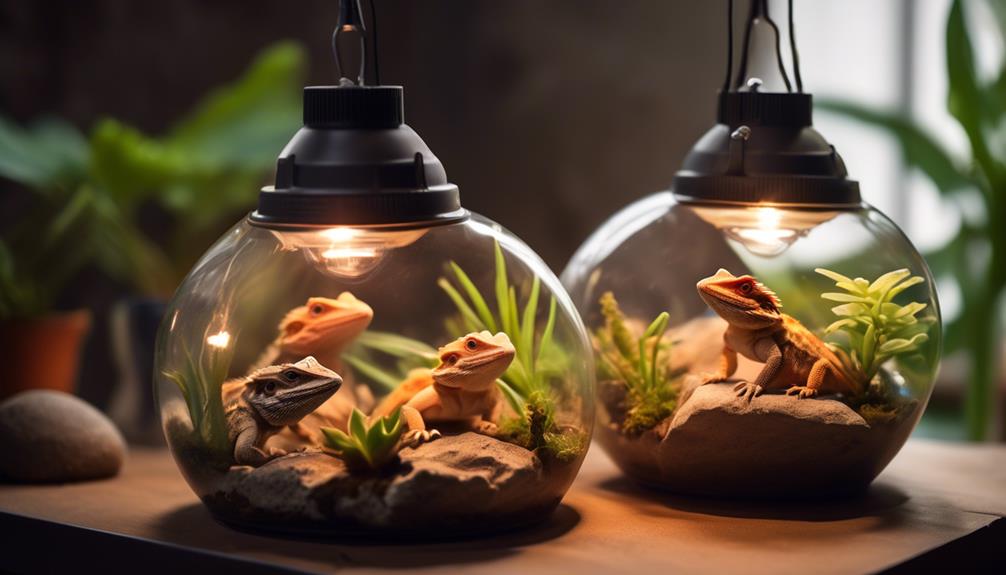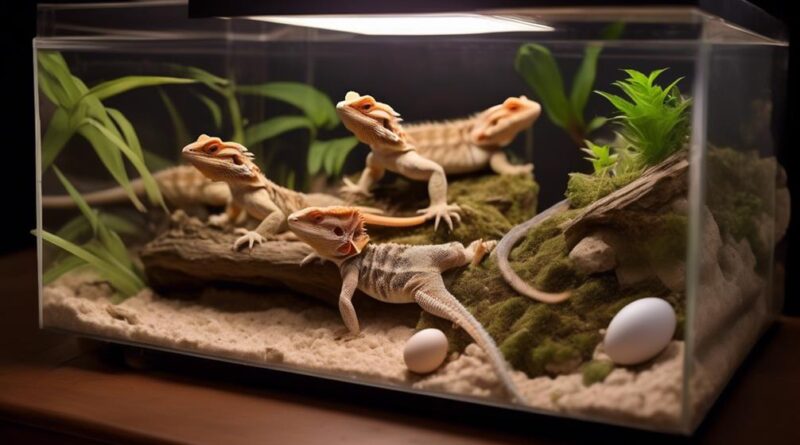Successful Bearded Dragon Breeding: A How-To Guide
So, you've decided to venture into the world of bearded dragon breeding. It's a rewarding and fascinating endeavor, but it requires careful planning and attention to detail.
From selecting the right breeding pairs to managing the incubation process, there are several crucial steps to consider.
The journey to successful bearded dragon breeding begins with understanding the intricacies of their reproductive behavior and creating an optimal environment for breeding.
Are you ready to embark on this journey and unlock the secrets to successful bearded dragon breeding?
Selecting Healthy Breeding Pairs
To ensure successful breeding, carefully select healthy pairs with strong genetic traits and robust physical characteristics. Genetic diversity plays a crucial role in the health and vitality of the offspring. When choosing breeding pairs, it's essential to consider their genetic backgrounds to maintain a diverse and resilient population. Look for dragons with different lineage and genetic makeup to promote genetic diversity and reduce the risk of hereditary diseases.
Breeding compatibility is another vital factor to consider. It's important to ensure that the selected pairs are compatible and able to reproduce successfully. Look for signs of mutual attraction and compatibility, such as the male displaying courtship behaviors and the female showing receptiveness. Observing their behavior and interactions can give you valuable insights into their compatibility and breeding potential.
When selecting breeding pairs, pay close attention to their physical traits. Choose dragons with robust physical characteristics, such as strong limbs, clear eyes, and healthy skin. Avoid selecting individuals with any visible physical deformities or health issues, as these traits can be passed down to the offspring, compromising their health and well-being.
Creating the Ideal Breeding Habitat
When creating the ideal breeding habitat for your bearded dragons, consider how their robust physical traits and genetic diversity from the previous breeding pair selection will contribute to the environment's suitability.
Temperature regulation plays a crucial role in the breeding habitat. Bearded dragons require a basking spot with temperatures ranging from 95°F to 110°F during the day and a cooler side of the enclosure with temperatures around 75°F to 85°F. By providing a temperature gradient, you allow your dragons to self-regulate their body temperature, which is essential for their overall health and breeding behaviors.
In addition to temperature regulation, it's important to address the dietary requirements of your breeding dragons. A well-balanced diet is essential for their health and successful breeding. Adult bearded dragons should be fed a variety of gut-loaded insects such as crickets, dubia roaches, and mealworms, as well as dark leafy greens and vegetables.
Proper nutrition is vital for the female's egg production and the male's reproductive health. Ensuring that your breeding pair has access to a nutritious and varied diet will contribute to their overall well-being and reproductive success.
Monitoring Female Health and Behavior
Ensuring the female bearded dragon's health and behavior are closely monitored is crucial during the breeding process to facilitate successful reproduction and address any potential complications promptly.
To ensure your female bearded dragon is in optimal health, it's important to pay close attention to her nutrition and behavior throughout the breeding process.
- Nutrition Monitoring
- Ensure the female bearded dragon is receiving a well-balanced diet that includes a variety of insects, leafy greens, and vegetables.
- Monitor her food intake and make adjustments as necessary to support her reproductive health.
- Behavioral Observations
- Keep an eye on her activity levels, as a decrease in activity could indicate potential health issues.
- Watch for any changes in her behavior, such as increased aggression or lethargy, which may signal the need for a veterinarian's attention.
Regularly assessing the female bearded dragon's nutrition and behavior will allow you to address any health concerns promptly, ensuring that she remains in optimal condition for successful breeding. By maintaining a keen eye on her health and behavior, you can support her overall well-being and increase the likelihood of a successful breeding outcome.
Understanding Breeding Cycles
Understanding the breeding cycles of bearded dragons is essential for successfully managing the reproductive process. Reproductive behavior in bearded dragons is influenced by hormonal changes, particularly in females. As the breeding season approaches, female dragons may exhibit increased activity levels, restlessness, and may become more territorial. These behavioral changes are indicative of breeding readiness. It's important to closely observe these signs to determine when the female is receptive to mating.
Hormonal changes in female bearded dragons also lead to the ovulation cycle. Ovulation is the release of eggs from the ovaries and typically occurs during the breeding season. During this time, female bearded dragons may display physical signs of ovulation such as a noticeable increase in abdomen size due to the developing eggs. This is an important indicator of the female's fertility and breeding readiness. Understanding the ovulation cycle is crucial for successful breeding as it allows breeders to predict the optimal time for mating and to ensure the female is in the best condition for egg development and laying.
Encouraging Courtship and Mating
To encourage courtship and mating in bearded dragons, provide a suitable breeding environment that includes ample space, hiding spots, and proper temperature and lighting conditions. Creating the right environment is crucial for stimulating the natural instincts of your bearded dragons and encouraging successful breeding.
Here's how you can encourage courtship and mating:
- Behavioral Cues
- Observe the behavior of your bearded dragons closely. Look for signs of courtship such as head bobbing, arm waving, and circling. Males may also display darkened beard colors during courtship. When you notice these behaviors, it's a good indication that your dragons are ready for mating.
- Environmental Stimuli
- Provide a spacious enclosure that allows for separate areas for each dragon to retreat to when needed. Incorporate hiding spots and visual barriers to create a sense of privacy and security. Additionally, ensure that the temperature and lighting in the enclosure mimic their natural habitat. Proper UVB lighting and a basking area are essential for maintaining their overall health and reproductive behaviors.
Managing Egg Incubation
Once the female bearded dragon has laid her eggs, you should carefully remove them from the laying site and prepare for the incubation process. The first step in managing egg incubation is to create a suitable nesting environment. Prepare a container with a mix of vermiculite and water, ensuring the substrate is damp but not overly wet. Gently place the eggs into the substrate, making sure they're partially buried without being completely covered.
Temperature regulation is crucial during the egg incubation process. Maintain a consistent temperature of around 82-84°F (28-29°C) within the incubation container. Use a reliable temperature-regulated heating source to achieve this. It's essential to monitor the temperature regularly to ensure it remains within the ideal range. Fluctuations can negatively impact the development of the eggs.
During this time, it's important to closely observe the nesting behavior and egg care of the female bearded dragon. While she may not be directly involved in the incubation process, her behavior can provide valuable insights into the health and viability of the eggs. Ensure she has access to fresh water and a balanced diet to support her during this period.
As the incubation period progresses, regularly check the eggs for any signs of mold, discoloration, or unusual odors. Moldy or discolored eggs should be removed immediately to prevent the spread of infection to healthy eggs. With attentive temperature regulation and careful observation, successful bearded dragon breeding through egg incubation can be achieved.
Caring for Hatchlings

Now that the hatchlings have emerged, it's essential to provide them with a suitable environment for their initial care and development. Be sure to give them the best possible start in life by following these essential care tips:
- Feeding Schedule:
Hatchlings require a diet with higher protein content to support their rapid growth. Offer them small insects such as appropriately sized crickets and mealworms daily. Dust the insects with a calcium supplement to ensure proper bone development. As the hatchlings grow, you can gradually introduce a variety of vegetables and fruits into their diet. Ensure fresh water is available at all times in a shallow dish that's easily accessible for the hatchlings.
- Socialization Techniques:
Proper socialization is crucial for hatchlings to grow into well-adjusted and friendly adults. Handle your hatchlings gently and frequently to accustom them to human interaction. This will help them become more comfortable with being handled as they mature. However, be mindful not to overstress them, especially in the first few weeks after hatching. Supervise any interactions with other hatchlings to prevent aggressive behavior and ensure they aren't competing excessively for food or resources.
Troubleshooting Breeding Challenges
If you encounter any breeding challenges, carefully observe the behavior and condition of your bearded dragons to identify and address any potential issues promptly. One common issue is egg binding, where a female bearded dragon struggles to lay her eggs. Signs of egg binding include lethargy, loss of appetite, and a swollen abdomen. If you notice these symptoms, seek veterinary assistance immediately, as egg binding can be life-threatening.
Infertile eggs are another challenge, often due to unsuccessful mating or the female laying eggs without mating. To prevent this, ensure that the male and female are properly introduced and observe mating behavior to confirm successful copulation.
Male aggression and mating rejection are also potential challenges. If you notice male aggression towards the female, separate them to avoid injury. Reintroduce them gradually and observe their behavior to ensure they're compatible.
Mating rejection can occur if the female isn't ready to breed or if the pair is incompatible. In such cases, allow the female to rest and try reintroducing the pair later. However, if rejection persists, consider finding a more suitable mate for your bearded dragon.
Frequently Asked Questions
What Are Some Common Health Issues That Can Arise During the Breeding Process and How Can They Be Prevented or Treated?
During the breeding process, it's important to be mindful of common health issues like egg binding and respiratory infections. Preventative care involves maintaining proper humidity levels and providing a nutritious diet. Treatment options may include veterinary intervention and supportive care.
Is It Possible to Breed Bearded Dragons of Different Morphs Together, and if So, Are There Any Special Considerations to Keep in Mind?
Yes, you can breed bearded dragons of different morphs together, but genetics compatibility and breeding considerations are crucial. Understanding the genetic traits and potential outcomes of the offspring is essential for successful breeding and healthy hatchlings.
How Can I Tell if My Female Bearded Dragon Is Experiencing Complications During Egg Laying, and What Should I Do to Help Her?
If your female bearded dragon is showing signs of nesting behavior but is struggling to lay eggs, she may be experiencing egg binding complications. Seek veterinary care immediately and consider calcium supplementation to support her during this time.
Are There Any Specific Dietary or Environmental Factors That Can Affect the Success of a Breeding Pair?
To ensure successful breeding, consider the dietary requirements and environmental conditions for your bearded dragon pair. Proper nutrition, ample space, and appropriate temperatures will help create a favorable environment for successful breeding and egg laying.
What Are Some Signs That a Hatchling May Be Experiencing Health Issues, and What Steps Should Be Taken to Address Them?
If your hatchling is experiencing health issues, look for signs like decreased activity, loss of appetite, or abnormal bowel movements. Ensure proper temperature, humidity, and diet. If symptoms persist, consult a reptile veterinarian for expert care tips.
Conclusion
Now that you have the knowledge and tools to successfully breed bearded dragons, you can confidently embark on this exciting journey.
Remember to:
- Select healthy breeding pairs
- Create the ideal habitat
- Monitor female health
- Understand breeding cycles
- Encourage courtship
- Manage egg incubation
With proper care and attention, you'll be able to care for hatchlings and troubleshoot any challenges that may arise.
Good luck and happy breeding!
